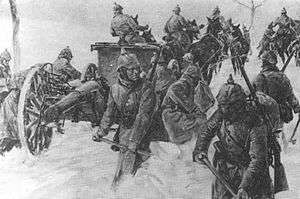Battle of Limanowa
The Battle of Limanowa took place from 1 December to 13 December 1914, between the Austro-Hungarian Army and the Russian Army near the town of Limanowa (40 kilometres (25 mi) south-east of Kraków).
The Austro-Hungarian high command had assumed that the German success would weaken Russian forces in the north and that the Galician front would remain quiet. Both these assumptions were incorrect.
Though the Habsburg 2nd army offensive opened on 16 November and met early success, the Russians proved stronger than expected and their 4th Army yielded little ground. Meanwhile, further south the Russian 2nd Army advanced across the San river and moved into the Tarnów area by 20 November. Further north, the Habsburg 4th Army, supported by the 47th German Reserve Division, moved onto the offensive in the last days of November.
In fierce battles around the towns of Łapanów and Limanowa, the Russian 3rd Army was beaten and forced to retreat east, ending its opportunity to reach Kraków. To avoid being surrounded, the Russian 8th Army also had to retreat, stopping its advance toward the Hungarian plains.
Order of battle
Russian forces
Russian Southwestern Front, Commander-in-chief – Nikolai Ivanov
- 3rd Army. Commander Radko Dimitriev
- XI. Corps General Vladimir Sacharow (11. 32. Division)
- IX. Corps General Dmitry Shcherbachev (5., 42. Division)
- X. Corps General Zerpitzki (9., 31. Division)
- XXI. Corps General Shkinski (33., 44. Division)
- 8th Army. Commander Alexei Brusilov
- VIII. Corps General Dragomirow (14., 15. Division)
- XXIV. Corps General Zurikow (48., 49. Division)
- VII. Corps General Eck (13., 34. Division)
Austro-Hungarian Forces
Commander-in-chief – Conrad von Hötzendorf
- 4th Army. Commander - Archduke Joseph Ferdinand
- XI. Corps FML Ljubicic (11.,15., 30. Division)
- XIV. Corps FML. Joseph Roth (3., 8. and 13. Division)
- German 47. Reserve Division (General Alfred Besser)
- VI. Corps FML Arz von Straußenburg (39., 45. Division)
- Cavalry-Corps Herberstein (6., 10., 11. Cavalry-Division)
- 3rd Army. Commander - General of Infantry Svetozar Boroevic
- 38. Honved-Division General Sandor Szurmay
- IX. Corps General Rudolf Kralicek (10., 26. Division)
- III. Corps General Emil Colerus von Geldern (6., 22., 28. Division)
- VII. Corps Archduke Joseph of Austria (17., 20. Division)
Results
The Russian threat to Krakow was eliminated and the Russians were pushed back across the Carpathians. The Austrian-Hungary forces claimed the battle as a victory.[1]
Sources
- Buttar, P. (2014). Collision of Empires: The War on the Eastern Front in 1914. Osprey Publishing. ISBN 978-1472813183.
References
- ↑ Buttar 2014, pp. 403-404.
Further reading
- Keegan, John. Der Erste Weltkrieg - Eine europäische Tragödie. – Rowohlt Taschenbuchverlag, Hamburg 2001. – ISBN 3-499-61194-5. (In German)
- Rauchensteiner, Manfried. Der Tod des Doppeladlers: Österreich-Ungarn und der Erste Weltkrieg. – Graz, Wien, Köln: Styria, 1993. – ISBN 3-222-12116-8. (In German)
- Roth von Limanowa, Josef. Die Schlacht von Limanowa-Lapanów, Dezember 1914. Innsbruck: Druck und Verlag der Kinderfreund-Anstalt, 1928. OCLC 36543649 (In German)
- Stone, Norman. The Eastern Front 1914-1917. – Hodder and Stoughton, London 1985. – ISBN 0-340-36035-6.
- Zenter, Christian. Der Erste Weltkrieg. – Mowegi-Verlag, Rastatt 2000. – ISBN 3-8118-1652-7. (In German)
